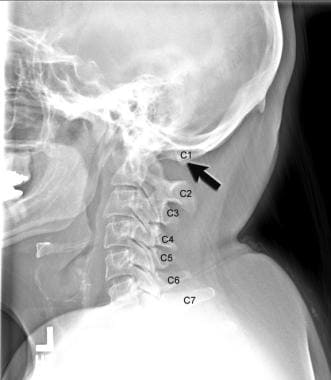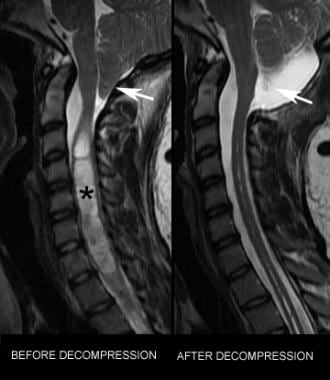Practice Essentials
Chiari malformations, types I-IV, refer to a spectrum of congenital hindbrain abnormalities affecting the structural relationships between the cerebellum, brainstem, the upper cervical cord, and the bony cranial base. [1, 2, 3, 4] (See the images below.)
Although Cleland described the first cases of Chiari malformation in 1883, the disorder is named after Hans Chiari, an Austrian pathologist, who classified Chiari malformations into types I through III in 1891. Chiari's colleague, Julius Arnold, made additional contributions to the definition of Chiari II malformation. [5] In his honor, students of Dr. Arnold later named the type II malformation Arnold-Chiari malformation. Other investigators later added the type IV malformation.
It is not at all clear that the 4 types of Chiari malformation represent a disease continuum corresponding to a single disorder. The 4 types (particularly types III and IV) are increasingly believed to have different pathogenesis and share little in common other than their names. Chiari type I malformation is the most common and the least severe of the spectrum, often diagnosed in adulthood. Chiari type II malformation is less common and more severe, almost invariably associated with myelomeningocele. Chiari type III and IV malformations are exceedingly rare and generally incompatible with life and are, therefore, of scant clinical significance.
Classification is based on the morphology of the malformations [4] :
-
Chiari I: >5mm descent of the caudal tip of cerebellar tonsils past the foramen magnum.
-
Chiari II: brainstem, fourth ventricle, and >5 mm descent of the caudal tip of cerebellar tonsils past the foramen magnum with spina bifida.
-
Chiari III: herniation of the cerebellum with or without the brainstem through a posterior encephalocele.
-
Chiari IV: Cerebellar hypoplasia or aplasia with normal posterior fossa and no hindbrain herniation.
This article discusses Chiari type I and II malformations with emphasis on the more common Chiari I malformation.
MRI is the most useful and most widely used imaging study for diagnosing Chiari malformation. CSF flow analysis through foramen magnum with phase-contrast cine MRI helps distinguish symptomatic Chiari I from asymptomatic cerebellar ectopia [6] and helps predict response to surgical decompression. [7] Other potentially useful tests include myelography as an alternative in patients in who cannot undergo MRI, and CT or radiographs of the neck and head, which may help reveal common associated bony defects, particularly of the craniocervical junction. [4, 8, 6, 7]
Patients with Chiari I malformations who have minimal or equivocal symptoms without syringomyelia can be treated conservatively. Mild neck pain and headaches can be treated with analgesics, muscle relaxants, and occasional use of a soft collar. Frankly symptomatic patients should be offered surgical treatment. The goals of surgical treatment are decompression of cervicomedullary junction and restoration of normal CSF flow in the region of foramen magnum. [9, 10, 11, 12, 13, 14, 15, 16]
The most common complications of Chiari decompression are pseudomeningocele formation and CSF leakage. [17, 18, 16] Chiari I patients may have an increased risk of concussion and postconcussion syndrome. [19]
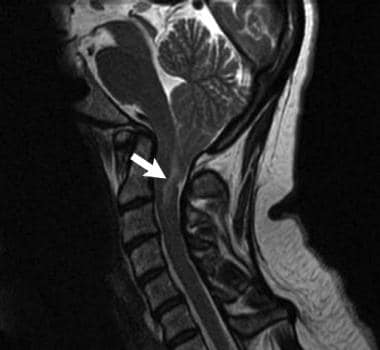 T2 hyperintense region on MRI (arrow) depicting edema in central cord region of a patient with Chiari I malformation. Left untreated, this patient is likely to develop cavitation of the edematous central cord, resulting in syringomyelia.
T2 hyperintense region on MRI (arrow) depicting edema in central cord region of a patient with Chiari I malformation. Left untreated, this patient is likely to develop cavitation of the edematous central cord, resulting in syringomyelia.
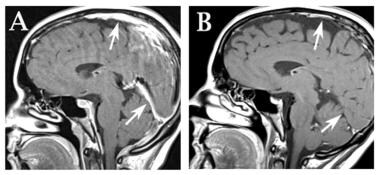 CSF hypotension syndrome: Postcontrast MRI before (A) and after (B) treatment with lumbar epidural blood patch. Notice the thick meningeal enhancement (arrows), the relative paucity of CSF in front of the brainstem and behind the cerebellar tonsils, and the engorgement of the pituitary gland before treatment (A). Notice reversal of these abnormalities and ascent of the cerebellar tonsils after treatment (B). In this case, an acquired Chiari malformation was not present, but in some cases it is.
CSF hypotension syndrome: Postcontrast MRI before (A) and after (B) treatment with lumbar epidural blood patch. Notice the thick meningeal enhancement (arrows), the relative paucity of CSF in front of the brainstem and behind the cerebellar tonsils, and the engorgement of the pituitary gland before treatment (A). Notice reversal of these abnormalities and ascent of the cerebellar tonsils after treatment (B). In this case, an acquired Chiari malformation was not present, but in some cases it is.
Problem
Chiari type I malformation is the most common and the least severe of the spectrum, often diagnosed in adulthood. Its hallmark is caudal displacement of peglike cerebellar tonsils below the level of the foramen magnum, a phenomenon variably referred to as congenital tonsillar herniation, tonsillar ectopia, or tonsillar descent. The resultant impaction of the foramen magnum, compression of the cervicomedullary junction by the ectopic tonsils, and interruption of normal flow of cerebrospinal fluid (CSF) through the region produce the clinical syndrome.
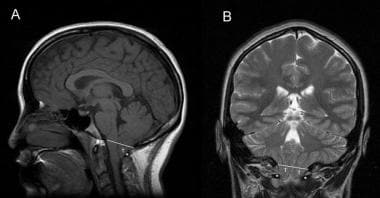 Sagittal and coronal MRI images of Chiari type I malformation. Note descent of cerebellar tonsils (T) below the level of foramen magnum (white line) down to the level of C1 posterior arch (asterisk).
Sagittal and coronal MRI images of Chiari type I malformation. Note descent of cerebellar tonsils (T) below the level of foramen magnum (white line) down to the level of C1 posterior arch (asterisk).
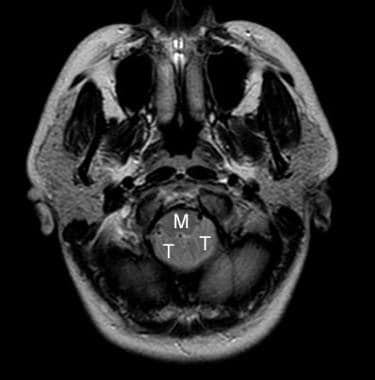 Axial MRI image at the level of foramen magnum in Chiari type I malformation. Note crowding of foramen magnum by the ectopic cerebellar tonsils (T) and the medulla (M). Also note the absence of cerebrospinal fluid.
Axial MRI image at the level of foramen magnum in Chiari type I malformation. Note crowding of foramen magnum by the ectopic cerebellar tonsils (T) and the medulla (M). Also note the absence of cerebrospinal fluid.
 Intraoperative photograph of Chiari type 1 malformation showing descent of cerebellar tonsils well below the level of foramen magnum.
Intraoperative photograph of Chiari type 1 malformation showing descent of cerebellar tonsils well below the level of foramen magnum.
Chiari type II malformation is less common and more severe, almost invariably associated with myelomeningocele. Because of its greater severity, it becomes symptomatic in infancy or early childhood. Its hallmark is caudal displacement of lower brainstem (medulla, pons, 4th ventricle) through the foramen magnum. Symptoms arise from dysfunction of brainstem and lower cranial nerves.
Chiari type III and IV malformations are exceedingly rare and generally incompatible with life and are, therefore, of scant clinical significance. The type III malformation refers to herniation of cerebellum into a high cervical myelomeningocele, [20] whereas type IV refers to cerebellar agenesis.
Importantly, it is not at all clear that the 4 types of Chiari malformation represent a disease continuum corresponding to a single disorder. The 4 types (particularly types III and IV) are increasingly believed to have different pathogenesis and share little in common other than their names.
Epidemiology
The most common Chiari malformation is type I and has been estimated to occur in 1 in 1000 births. The majority of these cases are asymptomatic. Chiari malformations are often detected coincidently among patients who have undergone diagnostic imaging for unrelated reasons. [21] There is a slight female predominance of 1.3:1. Chiari II is associated with neural tube defects, particularly myelomeningocele, in around 100% of cases. [4, 15, 22, 23]
Although Chiari malformation is still listed as a rare disease by the Office of Rare Diseases of the National Institutes of Health, this categorization is based on outdated data from before the MRI era. With routine use of MR imaging, Chiari malformation is discovered with increasing frequency. For Chiari I, prevalence rates of 0.1-0.5% with a slight female predominance have been suggested. [24] Chiari II is found in all children with myelomeningocele, although less than one third develop symptoms referable to this malformation. [22, 15]
In an analysis of patients with Chiari I over a 14-year period in the United States, 34% of Chiari I decompression operations were performed in patients younger than 20 years. Of adult patients who underwent decompression, 78% were female, whereas only 53% of children were female. The rate of decompression surgery increased 51% in younger patients from the first half to the second half of the study period and increased 28% in adult patients (20-65 yr of age). [15]
Etiology
Based on analysis of familial aggregation, a genetic basis for Chiari I has been suggested. [25, 26] Recent studies suggest linkage to chromosomes 9 and 15. [27] It is hypothesized that Chiari type I originates as a disorder of para-axial mesoderm, which subsequently results in formation of a small posterior fossa. The development of the cerebellum within this small compartment results in overcrowding of the posterior fossa, herniation of the cerebellar tonsils, and impaction of the foramen magnum. This theory is consistent with the observed association of Chiari I and other hereditary mesodermal connective tissue disorders, such as Ehlers-Danlos syndrome. [28]
Theories regarding embryogenesis of Chiari II malformation must take into account its invariable association with myelomeningocele. An attractive theory is the "CSF loss" theory. It is hypothesized that escape of fluid through the open placode in myelomeningocele results in an inadequate stimulus for mesenchymal condensation at the skull base. The disordered and inadequate growth of the posterior fossa results in upward herniation of vermis, downward herniation of brainstem, and distortion of tectum (tectal beaking). Furthermore, collapse of the developing ventricular system because of fluid loss results in associated abnormalities such as agenesis of corpus callosum and enlargement of massa intermedia. [22]
Pathophysiology
Symptoms of Chiari I develop as a result of 3 pathophysiological consequences of the disordered anatomy: (1) compression of medulla and upper spinal cord, (2) compression of cerebellum, and (3) disruption of CSF flow through foramen magnum. Compression of cord and medulla may result in myelopathy and lower cranial nerve and nuclear dysfunction. Compression of cerebellum may result in ataxia, dysmetria, nystagmus, and dysequilibrium. Disruption of CSF flow through foramen magnum probably accounts for the most common symptom, pain.
Accordingly, headache and neck pain in Chiari I are often exacerbated by cough and Valsalva maneuver. Hydrocephalus occurs less frequently. Furthermore, the disordered flow of CSF through foramen magnum may result in formation of syringomyelia and central cord symptoms such as hand weakness and dissociated sensory loss. These symptoms are usually asymmetrical, as a syrinx has a tendency to develop in the side of the spinal cord that is more significantly affected by tonsillar ectopia. [29]
 T2 hyperintense region on MRI (arrow) depicting edema in central cord region of a patient with Chiari I malformation. Left untreated, this patient is likely to develop cavitation of the edematous central cord, resulting in syringomyelia.
T2 hyperintense region on MRI (arrow) depicting edema in central cord region of a patient with Chiari I malformation. Left untreated, this patient is likely to develop cavitation of the edematous central cord, resulting in syringomyelia.
The pathophysiology of Chiari II is more complex. Although compressive mechanisms likely play a role, as in Chiari I, additional mechanisms may be operative in Chiari II. Stretching of abnormally oriented cranial nerves is believed to play a role. Chiari II may become acutely symptomatic with shunt malfunction, presumably because hydrocephalus further exacerbates the downward displacement of brainstem and stretching of cranial nerves. It has been suggested that irreversible ischemia of brainstem under tension may be responsible for the poorer prognosis of Chiari II after surgery compared with Chiari I. Furthermore, intrinsic neuroembryological abnormalities in Chiari II are widespread and not limited to the posterior fossa (eg, heterotopias, gyral abnormalities, callosal and thalamic abnormalities, in addition to hydrocephalus and myelomeningocele), further complicating the pathophysiology of this disorder.
Presentation
The clinical and patho-anatomical features and differences between Chiari I and II malformations are summarized in Table 1 below. [22, 28, 1, 30]
Table 1. Comparison of Chiari I and II Malformations (Open Table in a new window)
Characteristic |
Chiari I |
Chiari II |
Usual age of diagnosis |
Adults and older children |
Infants and young children |
Clinical findings |
|
|
Primary anatomical abnormalities |
|
|
Myelomeningocele |
No |
Always |
Hydrocephalus |
Less than 10% of cases |
Very common |
Syringomyelia |
30-70% |
Common |
Associated abnormalities |
|
|
Shared associated abnormalities |
|
|
Indications
In Chiari I, radiographic presence of tonsillar herniation must correlate with appropriate clinical signs and symptoms before surgical intervention is undertaken. In frankly symptomatic patients, such as those with lower cranial nerve dysfunction, myelopathy, syringomyelia, cerebellar symptoms, or severe post-tussive suboccipital headaches, the decision in favor of surgery is straightforward. Difficulty arises in minimally symptomatic patients or those with equivocal symptoms. CSF flow studies across foramen magnum with phase-contrast cine MRI (see Imaging Studies) may help with surgical decision-making in these cases.
Syringomyelia generally improves or resolves after surgical treatment of Chiari malformation. Rarely is shunting of the Chiari syrinx necessary.
Asymptomatic patients without syringomyelia whose Chiari I malformation has been discovered incidentally on MR imaging do not require surgery. In this group, if the radiographic abnormality appears significant, the patient should be educated about the disorder and asked to seek medical care should symptoms develop in the future.
In Chiari II, when neurological decompensation occurs, the first order of business is to treat hydrocephalus and rule out shunt malfunction. If evidence of brainstem dysfunction is present in spite of well-treated hydrocephalus and a functioning shunt, surgical decompression of Chiari II is undertaken.
Relevant Anatomy
The foramen magnum is an oval-shaped opening in the occipital bone, surrounded anteriorly by the clivus, laterally by the occipital condyles, and posteriorly by the squamous portion of the occipital bone. Normally, only the medulla traverses through the foramen magnum and merges seamlessly with the cervical cord. The lower extension of cisterna magna normally forms a large CSF cushion behind the medulla within the foramen magnum. This CSF cushion is replaced by cerebellar tonsils in Chiari I malformation.
Anatomical knowledge of the foramen magnum dura and its venous sinuses is of particular importance in surgical treatment. The dura that is applied to the inner surface of the squamous portion of occipital bone funnels abruptly into a cylindrical tube at the level of foramen magnum. The squamous occipital dura is bisected vertically by the cerebellar falx. The depth of cerebellar fax between the cerebellar hemispheres diminishes near the foramen magnum. The occipital sinus runs down from the torcula in the trigone formed by the dural leaflets of cerebellar falx and squamous occipital dura. As it approaches the foramen magnum, the occipital sinus divides into two divergent limbs which course laterally around the foramen magnum to join the sigmoid sinuses or the jugular bulbs.
During surgery, dural openings across the foramen magnum are carried out in a Y-shaped fashion in order to avoid the deep part of cerebellar falx and the vertical midline portion of occipital sinus. The two lower limbs of the occipital sinus are transected individually by the two oblique limbs of the Y-shaped incision.
Contraindications
Surgical decompression of foramen magnum is contraindicated when tonsillar herniation is caused by etiologies other than Chiari malformation, such as mass lesions in the posterior fossa or CSF hypotension syndrome.
Mass lesions in the posterior fossa can result in tonsillar herniation. The correct diagnosis can be missed if tonsillar herniation has been diagnosed by a cervical spine MRI, which has not adequately visualized all of the posterior fossa. Alternatively, if the patient could not have an MRI and the diagnosis has been made with a noncontrast CT or CT-myelography, the mass lesion can be missed. Clearly, treating the tonsillar herniation without addressing the mass lesion would be contraindicated.
CSF hypotension syndrome can result in tonsillar herniation. Frequently, these patients complain of headache and neck pain. They may even present with cranial nerve dysfunction, mimicking the symptoms of Chiari malformation. The correct diagnosis can be made with careful attention to the history and radiographic findings. Patients with CSF hypotension syndrome usually present with postural headaches, worse with standing and relieved by rest. MRI shows deflation of the prepontine cistern and sagging of the brainstem against the clivus. Unlike Chiari, the posterior fossa volume is normal. Most dramatically, postcontrast MRI reveals intense dural enhancement throughout the cranium due to venous engorgement, facilitating the diagnosis. Patients with CSF hypotension syndrome are treated with epidural blood patches. If MRI is repeated after clinical improvement, correction of tonsillar ectopia is noted.
 CSF hypotension syndrome: Postcontrast MRI before (A) and after (B) treatment with lumbar epidural blood patch. Notice the thick meningeal enhancement (arrows), the relative paucity of CSF in front of the brainstem and behind the cerebellar tonsils, and the engorgement of the pituitary gland before treatment (A). Notice reversal of these abnormalities and ascent of the cerebellar tonsils after treatment (B). In this case, an acquired Chiari malformation was not present, but in some cases it is.
CSF hypotension syndrome: Postcontrast MRI before (A) and after (B) treatment with lumbar epidural blood patch. Notice the thick meningeal enhancement (arrows), the relative paucity of CSF in front of the brainstem and behind the cerebellar tonsils, and the engorgement of the pituitary gland before treatment (A). Notice reversal of these abnormalities and ascent of the cerebellar tonsils after treatment (B). In this case, an acquired Chiari malformation was not present, but in some cases it is.
-
Sagittal and coronal MRI images of Chiari type I malformation. Note descent of cerebellar tonsils (T) below the level of foramen magnum (white line) down to the level of C1 posterior arch (asterisk).
-
Axial MRI image at the level of foramen magnum in Chiari type I malformation. Note crowding of foramen magnum by the ectopic cerebellar tonsils (T) and the medulla (M). Also note the absence of cerebrospinal fluid.
-
Occipitalization of atlas in a patient with Chiari I.
-
T2 hyperintense region on MRI (arrow) depicting edema in central cord region of a patient with Chiari I malformation. Left untreated, this patient is likely to develop cavitation of the edematous central cord, resulting in syringomyelia.
-
CSF hypotension syndrome: Postcontrast MRI before (A) and after (B) treatment with lumbar epidural blood patch. Notice the thick meningeal enhancement (arrows), the relative paucity of CSF in front of the brainstem and behind the cerebellar tonsils, and the engorgement of the pituitary gland before treatment (A). Notice reversal of these abnormalities and ascent of the cerebellar tonsils after treatment (B). In this case, an acquired Chiari malformation was not present, but in some cases it is.
-
CSF flow study with phase-contrast cine MRI. Brain pulsations results in caudad and cephalad flow of CSF across foramen magnum during systole and diastole. The reversal in the direction of flow is picked up by alternating light and dark appearance of CSF in front and behind the medulla and upper spinal cord on phase-contrast cine MRI. In this case of Chiari I malformation, note the complete absence of CSF flow behind (arrowheads) and focal constriction of CSF flow (arrows) in front of cervicomedullary junction.
-
Resolution of syringomyelia (asterisk) after decompression of Chiari I malformation (white arrow).
-
Intraoperative photograph of Chiari type 1 malformation showing descent of cerebellar tonsils well below the level of foramen magnum.
-
Intraoperative photograph of duraplasty with pericranial graft. The duraplasty provides additional room for cerebellar tonsils at the craniocervical junction, while achieving closure of dura and prevention of cerebrospinal fluid leak.

